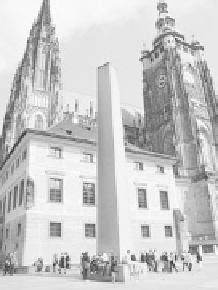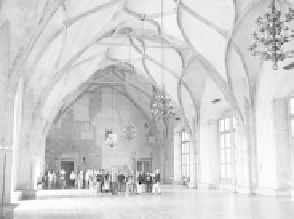Travel Reference
In-Depth Information
establishment of Czechoslovakia and
commemorating the soldiers who
fought for its independence. It was
originally much taller, but broke in
transit—an inauspicious start for a
nation destined to last only 70 years.
Up in the fat, green tower of the
cathedral is the Czech Republic's
biggest bell, nicknamed “Zikmund.”
In June of 2002, it cracked—and
two months later, the worst flood in
recorded history hit the city—which
the locals saw as a sign. As a nation
sandwiched between great powers, Czechs are deeply superstitious
when it comes to the tides of history. Often feeling unable to influ-
ence the course of their own destiny, they helplessly look at events
as we might look at the weather and other natural phenomena—
trying to figure out what fate has in store for them next.
Find the 14th-century
mosaic
of the Last Judgment outside
on the right transept. It was commissioned in the Italian style by
King Charles IV, who was modern, cosmopolitan, and ahead of his
time. Jesus oversees the action, as some go to heaven and some go
to hell. The Czech king and queen kneel directly below Jesus and
the six patron saints. On coronation day, they would walk under
this arch, which would remind them (and their subjects) that even
those holding great power are not above God's judgment. The royal
crown and national jewels are kept in a chamber (see the grilled
windows) above this entryway, which was the cathedral's main
entry for centuries while the church remained uncompleted.
Across the square and 20 yards to the right, a door leads into
the Old Royal Palace (in the lobby, there's a WC with a window
shared by the men's and women's sections—meet your partner to
enjoy the view).
Old Royal Palace (Starý Královský Palác)
—Starting in the
12th century, this was the seat of the Bohemian princes. While
extensively rebuilt, the
large hall
is late Gothic, designed as a multi-
purpose hall for the old nobility.
It's big enough for jousts—even
the staircase was designed to let a
mounted soldier gallop in. It was
filled with market stalls, giving
nobles a chance to shop without
actually going into town. In the
1400s, the nobility met here to
elect their king. The tradition sur-
vived until modern times, as the






















